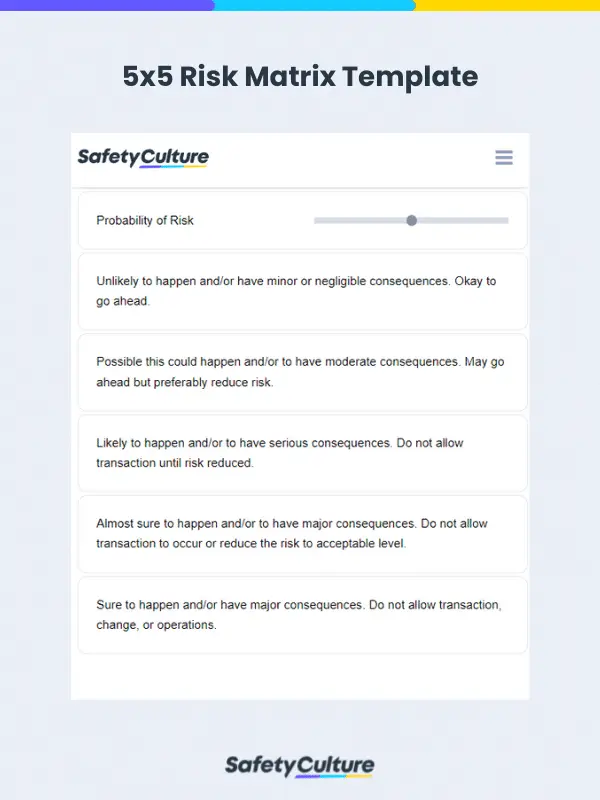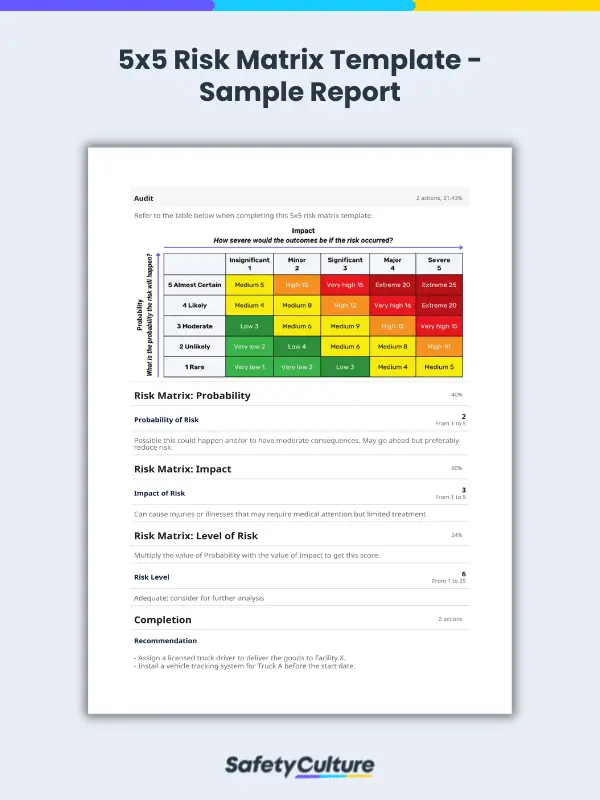What is a 5×5 Risk Matrix Template?
A 5×5 risk matrix template is a tool used to measure risk levels according to their likelihood and impact on an organization. It presents risk information using a color-coded tabular matrix with an expanded numerical scaling system. This in-depth visualization allows health and safety (H&S) officers and project managers to take a more granular approach in calculating risks and devising appropriate intervention strategies.
Advantages
A 5×5 risk matrix template is a valuable risk assessment tool for projects, management systems, worksites, and similar undertakings. Here are three ways you can benefit from using this tool:
Streamlining Risk Assessments
First, it provides a more efficient and structured approach to risk assessment. A template already includes all the elements needed in a risk matrix to help you save time from manually replicating it every time. This way, you can proceed with assessing risks without worrying about missing any important items.
Visualizing Risk Information
This risk matrix template also presents a clear picture of risks across degrees of probability and consequences. The numerical values in the matrix take a quantitative approach to understanding the gravity of each risk factor with more depth. Meanwhile, its color coding system allows you to pinpoint high-risk areas that require immediate attention.
Establishing Compliant Health and Safety Programs
By simplifying this process, it becomes easier to follow legal requirements and standards for health and safety programs from (but not limited to) the following agencies:
- Health and Safety Executive (HSE) – In the UK, risk assessments are a must to determine the potential risks for employees at work and take action accordingly.
- Occupational Safety and Health Administration (OSHA) – While not a requirement for legal compliance, the US government’s OSHA recommends incorporating risk and hazard assessments in a workplace’s health and safety program.
- Canadian Centre for Occupational Health and Safety (CCOHS) – It also considers risk assessment an integral part of a robust health and safety initiative.
What Should It Include?
A 5×5 risk matrix template typically consists of the following elements:
- Probability – Also known as likelihood, it measures how possible it is for a risk to occur in a project or organization.
- Impact – Also known as severity or consequence, it indicates the extent to which the risk will affect the project or organization.
- Risk level – This value reflects the degree of threat that a potential risk presents to the project or organization according to its likelihood and impact.
- Recommendation – This field lets you list down appropriate risk control measures to combat, mitigate, or manage the potential threat.
How to Use a 5×5 Risk Matrix Template (+ Example)
After learning about the components of a 5×5 risk matrix, it’s time to put this knowledge into practice. Here are five steps for using this template, along with an example.
Step #1: Establish the Project Details.
Before mapping out the risk landscape, it’s important to provide a background on the system, project, or worksite to be evaluated. Thus, the first step is to outline essential information about the activity in review, including its potential risks to your employees and your organization.
Step #2: Identify the Risk Probability.
Once the project details are complete, it’s time to build your 5×5 risk matrix template. Start by determining how likely the risk will occur in your project, system, or worksite based on a 1-5 scoring system as follows:
- Rare – has less than 10 percent chance of the risk occurring
- Unlikely – can possibly happen but only with a less than 50 percent chance
- Moderate – likely to occur with the odds left at a 50:50 split
- Likely – more possible to happen, with the odds ranging from 60-80 percent
- Almost certain – highly probable to happen, with over 80 percent chance of occurrence
Step #3: Determine the Risk Impact.
Next, you’ll need to rate the extent to which a risk factor can affect the activity you’re assessing. As this is a 5×5 risk matrix template, it will follow a 1-5 scale as follows:
- Insignificant – negligible consequences without causing serious harm
- Minor – minimal consequences, leading to mild injuries or illnesses
- Significant – manageable consequences, causing harm that may require short-term treatment
- Major – critical consequences, leading to long-term damages
- Severe – devastating consequences, resulting in fatalities and catastrophic damages
Step #4: Calculate the Overall Risk Level.
Once you have rated the Probability and Impact of a risk factor, determine the risk level by multiplying these two values. The result can range from the following:
- Acceptable (1-4) – requires no further action
- Adequate (5-9) – needs further observation and assessment
- Tolerable (10-16) – requires regular monitoring and improvement interventions
- Unacceptable (17-25) – halt operations and enact corrective action
Step #5: Provide Recommendations.
This 5×5 risk matrix template takes things to the next level through proactive risk resolution. For this section, you can suggest risk control measures and appropriate interventions to prevent, mitigate, or manage existing risks.
See the example below for a complete picture of how a 5×5 risk matrix template works in an inventory transportation setting.
FAQs about 5x5 Risk Matrix Templates
- Place the risk probability in the Y-axis (column) of the template using a 1-5 rating system (1 = Rare, 5 = Almost Certain).
- Insert the risk impact in the X-axis (row) of the template following the same 1-5 scale (1 = Insignificant, 4 = Severe).
- Determine the risk level by multiplying Probability by Impact.
- Following the formula above, ascribe a numerical value (1-25) and color (green to red) to each cell in the matrix.
Risk matrix templates typically come in three formats: the 3×3 risk matrix, 4×4 risk matrix, and 5×5 risk matrix. Each matrix depicts varying levels of impact and likelihood, depending on the scale you want to use.
In a 5×5 risk matrix template, the levels of risk go as follows:
- Acceptable – no further action required, but make sure to maintain controls.
- Adequate – consider for further analysis.
- Tolerable – review in a timely manner to carry out improvement strategies.
- Unacceptable – cease activities and endorse immediate action.




